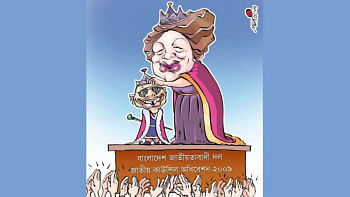Air quality in districts: Cleanest in Madaripur, worst in Gazipur

"The government organisations in charge of regulating the air quality have no accountability. Had it been there, they would have been brought to book for their failure and exposing the whole nation to high levels of air pollution."
Gazipur has the most polluted air out of 64 districts in Bangladesh and Madaripur the least, found a recent study.
The permissible limit set by the Department of Environment for fine particulate matter (PM 2.5) -- which refers to the tiny particles or droplets in the air that reduce visibility and cause the air to appear hazy when levels are elevated -- is 65 micrograms per cubic metre.
Gazipur's PM 2.5 level was found to be 263.51 micrograms per cubic metre, according to the study conducted by the Stamford University's Centre for Atmospheric Pollution Study last year on air quality from 3,163 spots across the country.
On average, Bangladesh's PM 2.5 level was 102.41 micrograms per cubic metre, according to the study, unveiled yesterday.
Professor Md Ahmed Kamruzzaman Majumder who led the study team of 81 said it was first ever study on air quality of 64 districts.
Other than the obvious respiratory ailments, high levels of PM 2.5 affect the kidney and liver too.
"In Bangladesh, kidney problem is becoming acute, with eight lakh patients currently requiring dialysis," said Lenin Chowdhury, a public health expert.
Gazipur was followed by Dhaka and Narayanganj respectively.
Hundreds of brick kilns, thousands of industries, excavation for development works, unfit vehicles, burning of wastage account for the high concentration of PM 2.5 in Gazipur, Dhaka and Narayanganj's air, the study said.
As many as 18 districts including Habiganj, Noakhali, Cox's Bazar and Moulvibazar have high levels of PM 2.5.
Madaripur, the district with the healthiest air quality in Bangladesh, had a PM of 49.08 micrograms per cubic metre thanks to thousands of water bodies, ponds, ditches and greenery.
Nine other districts have similar air quality including Kurigram, Natore, Rajshahi, Pabna, Sirajganj and Patuakhali.
As many as 36 districts including Jashore, Gopalganj, Narsingdi, Gaibandha, Rangamati and Cumilla have moderate air quality.
Among the divisional cities, Rajshahi performed the best with a PM 2.5 level of 56.41 micrograms per cubic metre and Dhaka the worst (252.93 micrograms per cubic metre).
The government organisations in charge of regulating the air quality have no accountability, Sharif Jamil, general secretary of the Bangladesh Paribesh Andolon, told The Daily Star.
"Had it been there, they would have been brought to book for their failure and exposing the whole nation to high levels of air pollution."
People's participation must be ensured in air quality monitoring mechanisms, he said, while calling for amendments to the environment law so that people can go to court for suffering from environmental hazards.
"And foreign companies working in development projects must comply with the environmental guidelines," Jamil added.
Air pollution affects the plants and wildlife, disturbing the ecological balance, said Mohammad Zashim Uddin, a professor at Dhaka University's botany department.
"We must take the crisis seriously to find a solution," he added.
The study also provided short-, mid- and long-term recommendations for mitigating the crisis.
Short-term actions include sprinkling water every two to three hours by Wasa and city corporations, ensuring construction materials are covered with tarpaulin, using suction trucks to remove dust, shutting down brick kilns and getting rid of unfit vehicles from the roads.
Mid-term actions comprise planting trees, initiating separate lanes for bicycles, conserving waterbodies and coordination among service providing agencies.
Long-term solutions include enacting the Clean Air Act, increasing the budgetary allocation for environment, forest and climate change ministry, setting up an air monitoring station and real-time air quality displays to provide timely air quality data for citizens, improving the traffic system and initiating environment cadre service.

 For all latest news, follow The Daily Star's Google News channel.
For all latest news, follow The Daily Star's Google News channel. 



Comments